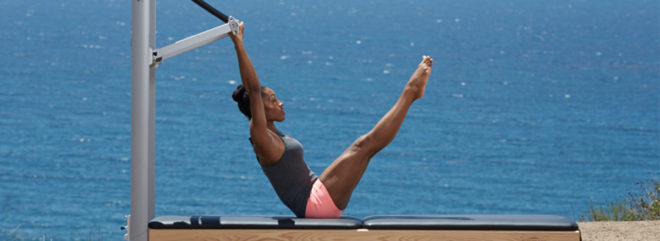By Zoey Trap
I love the Teaser. In fact, I have never met a Teaser I don’t like.
From my first Teaser I on the mat, I was hooked. From the Teaser on the reformer and Cadillac to the Teaser on the chair or spine corrector—I love them all. Unfortunately, my enthusiasm is not enough to make all my students as fond of Teaser as I am. Let’s look at some ways of helping students to execute the Teaser on any apparatus.
Teaser I requires a strong powerhouse connection with enough lower back and hamstring flexibility to bring the lower body and torso together. It’s a tough exercise that requires the student to pull up against gravity while holding his or her legs still. Obviously, it is a challenge for all of the critical connections (three anchors, heel to seat, rib to scapula), but it’s also a critical marker exercise. This means it marks a jump in progress. So when your student does Teaser I, be sure to celebrate their strength and progress!
The work towards Teaser I takes places in the very first lesson as we start building the 4 Ss (stability, strength, stamina, stretch). It is also found in the Shapes in Space of the Roll Up on the mat, and in the Roll Down on the Cadillac and wall. Teaser I is just the Roll Up, tipped up! And if you think about it, if you introduce Roll Up from Seated Roll Back, then that’s the Teaser with knees bent and both feet on the floor.
One of the greatest challenges of progressing the Teaser with preparatory exercises and building blocks is understanding what is lacking in the movement pattern. (Just a reminder, a preparatory exercise builds necessary strength and flexibility to prepare a student for an exercise, but may not meet the goal of an exercise. Using a building block lowers the intensity of an exercise while still meeting the exercise .) Watch your student as they do exercises that require them to roll their pelvis and articulate their spine. What do you see? For example:
- If they are having trouble rolling their pelvis, help them with the initiation pattern. A good preparatory exercise is to have them sit at the front of the mat, knees bent and feet down, with a sponge ball behind their back. Cue them to pull their tail under, to bring their seat under toward their feet. They will roll back into the ball, a very limited range of motion and only have to work on just that one aspect of the Teaser. You can increase the range of motion by using a wedge, which will require them to lower down much farther, but not all the way.
- For students who are struggling with the Teaser One Leg, try placing a dynaband around the foot of the lifted leg. Have the student climb up the band hand over hand and then slide back down in a controlled fashion to the floor. This little accessory can help them build the strength they need. Remind them to use the abs as much as possible and just get a little assist from the arms!
- If you have a student who is having trouble holding their legs in the air, place a stability ball under their feet or place their feet in the trapeze strap. Encourage the student to fire up their heel to seat connection and lift up. You can also use the dynaband over both feet and have them climb up and down.
- With a student who collapses thier ribs onto their hips, have them sit at the front of the mat either with the knees bent and feet down or legs in the air depending on the student’s strength. Cue them to strongly lift both sides of her waist and keep the ribs off the hips while they lift and lower the arms holding the position with length in the torso.
- If you have a student who just can seem to coordinate the movement, this building block can be a life saver: lying supine, bend the knees to the chest and place hands on backs of thighs. Bring head up and activate the abdominals deeply and press the legs away from the face and into the hands to sit up into Teaser I with the knees bent. At the top of the movement, straighten the legs. To return back down, bend the knees and bring shins parallel to the floor. Hold them still while you articulate down onto the mat. Fold the knees to the chest and repeat.
Teasers are fun if you approach them as fun. The ideas listed here will help you not only in one-on-one sessions, but they work nicely in groups as well when you cannot spot each student. In a one-on-one situation, you can also place the student’s feet on your legs and guide their hands to assist them up. So get going! Be a pleaser – teach the Teaser!
For more tips about exercise modifications, subscribe to our newsletter!



